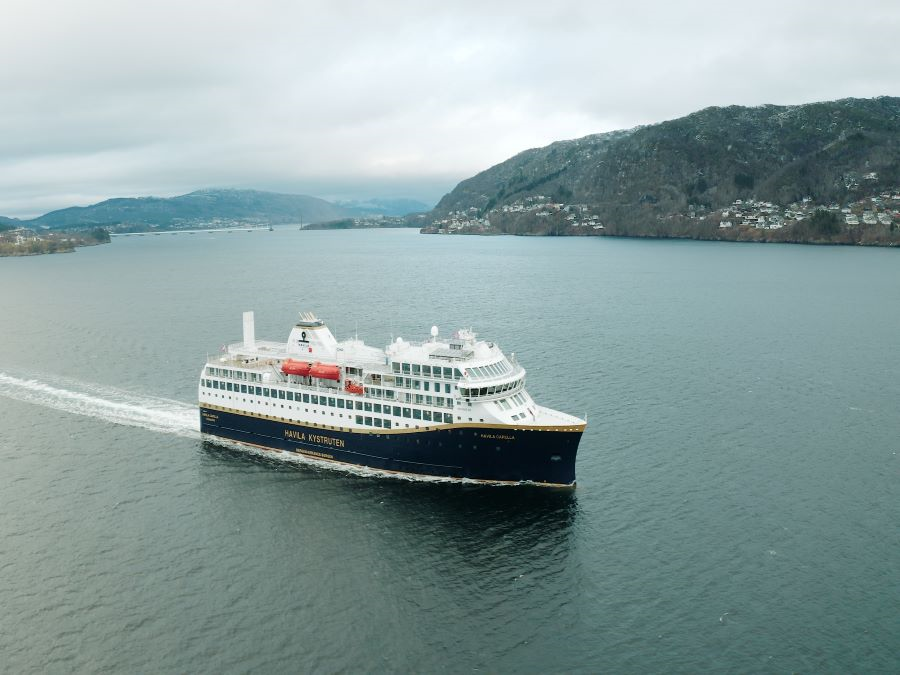
Havila Capella is the first new ship to sail on the Norwegian coastal route between Bergen to Kirkenes in 18 years. On 12 December 2021, the Havila Capella set out on its maiden voyage along the coast. The plug-in hybrid ship partly relies on a large battery pack with a capacity of 6.1MWh, which is estimated to be the equivalent of 600 Teslas.
Bent Martini, CEO of Havila Kystruten, says: “These vessels are equipped with LNG engines, electric engines combined with a battery package. They are hybrid vessels. On the emissions side, the vessels’ NOx is reduced by 90% and CO2 is reduced by 25%.
“We are also able to run on biogas to reduce CO2 footprint by up to 90% and the battery package lasts four hours. Usually, when you sail along the coast you are using the battery package to do peak shaving, so the vessel uses less fuel.”
Peak shaving avoids the unnecessary start-up of standby engines. The hybrid powering of the ship allows peak loads to be managed by the smoothing of engine loads.
“Today, the price of LNG is very high and taxes depend on different countries. However, this engine is the most effective for reducing CO2 compared to fossil fuels,” adds Martini.
Havila Capella: a zero-emission ship
The 124m ship includes 179 cabins and accommodates 640 passengers. The hull is designed to be energy-efficient with fuel usage kept low, and it is also designed to withstand the weather on the voyage along the Norwegian coast. Excess heat is extracted from cooling water in order to provide heating on board the ship.

US Tariffs are shifting - will you react or anticipate?
Don’t let policy changes catch you off guard. Stay proactive with real-time data and expert analysis.
By GlobalData
The coastal express routes and ships on the Bergen-Kirkenes stretch are an important part of everyday life for the public and those who have businesses that rely on ships. The routes and ships provide service to travellers and to those who are responsible for transporting goods.
Being a zero-emission ship, it is possible for the Havila Capella to sail through world heritage fjords found on the Norwegian coast without noise.
The ship also crosses the Arctic Circle, allowing passengers the opportunity to view the Northern Lights. The voyage runs up to a few kilometres away from Russia, the road signs in Kirkenes being in Norwegian and Russian.
The coastal ship has been decorated in a Nordic style and the large windows allow for views of the Norwegian coast while also letting in natural light to the ship as a result.
In addition, the voyages of these ships are expected to significantly reduce food waste. It has been estimated that food waste will be reduced by a total of 60 tonnes per years due to the passengers on board being served at their tables as opposed to being able to access buffets on the ships.
Joining the Havila fleet
There is an agreement in place between Havila Voyages and the Norwegian Ministry of Transport and Communications that saw, in 2018, the Norwegian Ministry of Transportation and Communications split the service of the route into three contracts from 2021 to 2030.
As a result of this, Havila Voyages is expected to operate four of the 11 ships that sail the route between Bergen and Kirkenes until 2030. The other two contracts were won by Hurtigruten, another shipping company, which will operate the other seven ships which will use the route.
The ships are expected to sail all year between Bergen and Kirkenes, departing daily and calling at 34 ports.
Havila Castor will start operating from Bergen on 10 May, which is a month later than expected. The ship has been unable to carry out sea trials due to challenges relating to an electric motor at the shipyard in Turkey.
Havila Polaris is expected to start operating in Q3 of this year due to the delay and Havila Pollux is expected to start operating in Q4. The Norwegian Ministry of Transport and Communications will not expect replacement ships to be in place during these delays.
Notably, the same design and technology that has been used for Havila Capella has been used in these ships.
The environmental total investment on the Havila vessels was around NOK 500m ($57m).
“I think most companies today are focused on how to reduce emissions but when you are building vessels for 25 years or 30 years, you are investing big money and a lot of companies feel as though the technology is not really there yet to invest in environmental improvements,” says Martini.
“We have prepared the vessels for converting to hydrogen and we are willing to take investments to reduce emissions.”



